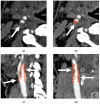Computed Tomography Texture Analysis of Carotid Plaque as Predictor of Unfavorable Outcome after Carotid Artery Stenting: A Preliminary Study
- PMID: 34943451
- PMCID: PMC8699962
- DOI: 10.3390/diagnostics11122214
Computed Tomography Texture Analysis of Carotid Plaque as Predictor of Unfavorable Outcome after Carotid Artery Stenting: A Preliminary Study
Abstract
Novel biomarkers are advocated to manage carotid plaques. Therefore, we aimed to test the association between textural features of carotid plaque at computed tomography angiography (CTA) and unfavorable outcome after carotid artery stenting (CAS). Between January 2010 and January 2021, were selected 172 patients (median age, 77 years; 112/172, 65% men) who underwent CAS with CTA of the supra-aortic vessels performed within prior 6 months. Standard descriptors of the density histogram were derived by open-source software automated analysis obtained by CTA plaque segmentation. Multiple logistic regression analysis, receiver operating characteristic (ROC) curve analysis and the area under the ROC (AUC) were used to identify potential prognostic variables and to assess the model performance for predicting unfavorable outcome (periprocedural death or myocardial infarction and any ipsilateral acute neurological event). Unfavorable outcome occurred in 17/172 (10%) patients (median age, 79 years; 12/17, 70% men). Kurtosis was an independent predictor of unfavorable outcome (odds ratio, 0.79; confidence interval, 0.65-0.97; p = 0.029). The predictive model for unfavorable outcome including CTA textural features outperformed the model without textural features (AUC 0.789 vs. 0.695, p = 0.004). In patients with stenotic carotid plaque, kurtosis derived by CTA density histogram analysis is an independent predictor of unfavorable outcome after CAS.
Keywords: brain; carotid artery disorders; computer software applications; stents; vascular accident.
Conflict of interest statement
The authors declare no conflict of interest.
Figures



References
-
- Naghavi M., Wang H., Lozano R., Davis A., Liang X., Zhou M., Vollset S.E., Abbasoglu Ozgoren A., Abdalla S., Abd-Allah F., et al. Global, regional, and national age–sex specific all-cause and cause-specific mortality for 240 causes of death, 1990–2013: A systematic analysis for the Global Burden of Disease Study 2013. Lancet. 2015;385:117–171. doi: 10.1016/s0140-6736(14)61682-2. - DOI - PMC - PubMed
-
- Sardar P., Chatterjee S., Aronow H.D., Kundu A., Ramchand P., Mukherjee D., Nairooz R., Gray W.A., White C., Jaff M.R., et al. Carotid Artery Stenting Versus Endarterectomy for Stroke Prevention: A Meta-Analysis of Clinical Trials. J. Am. Coll. Cardiol. 2017;69:2266–2275. doi: 10.1016/j.jacc.2017.02.053. - DOI - PubMed
LinkOut - more resources
Full Text Sources

